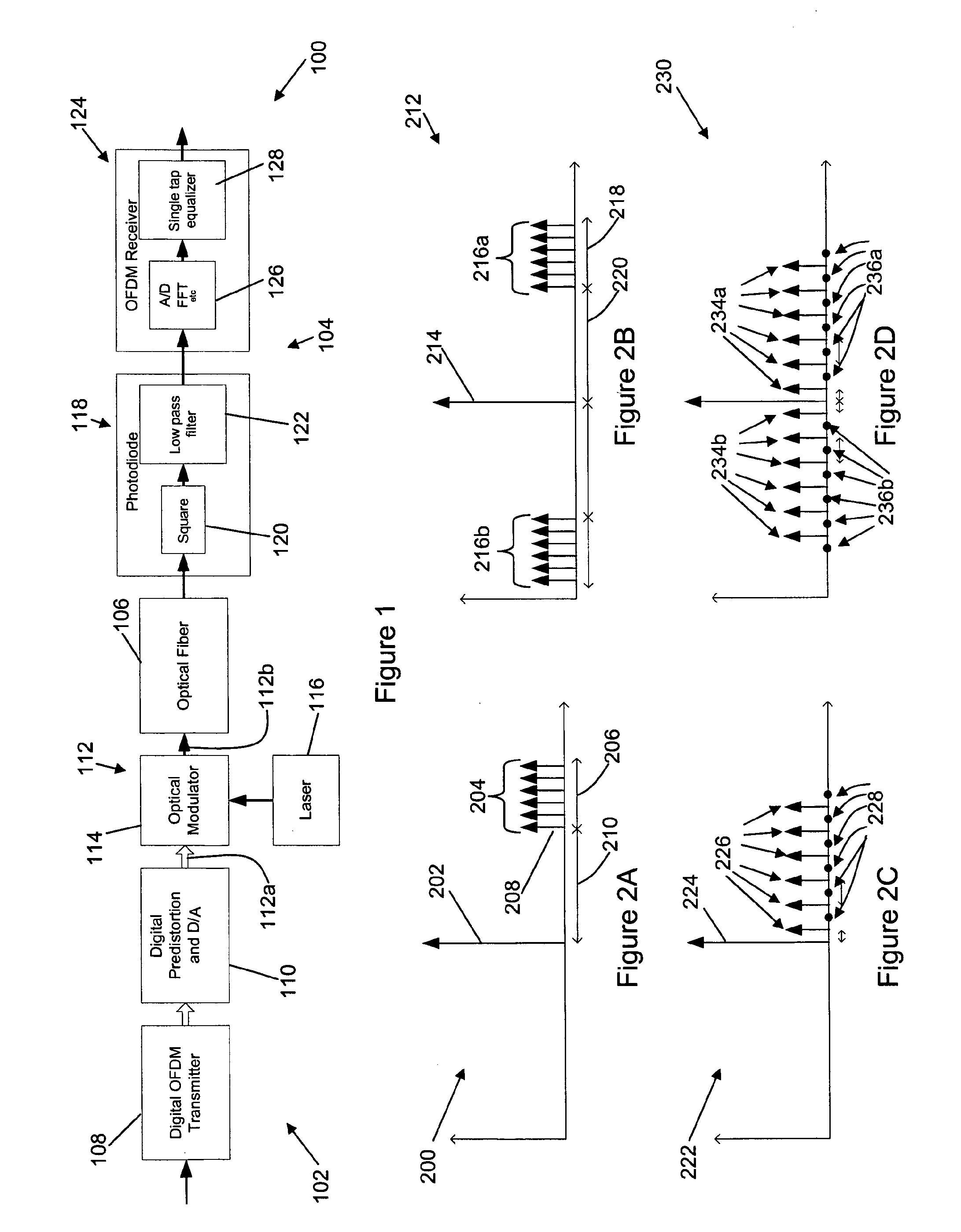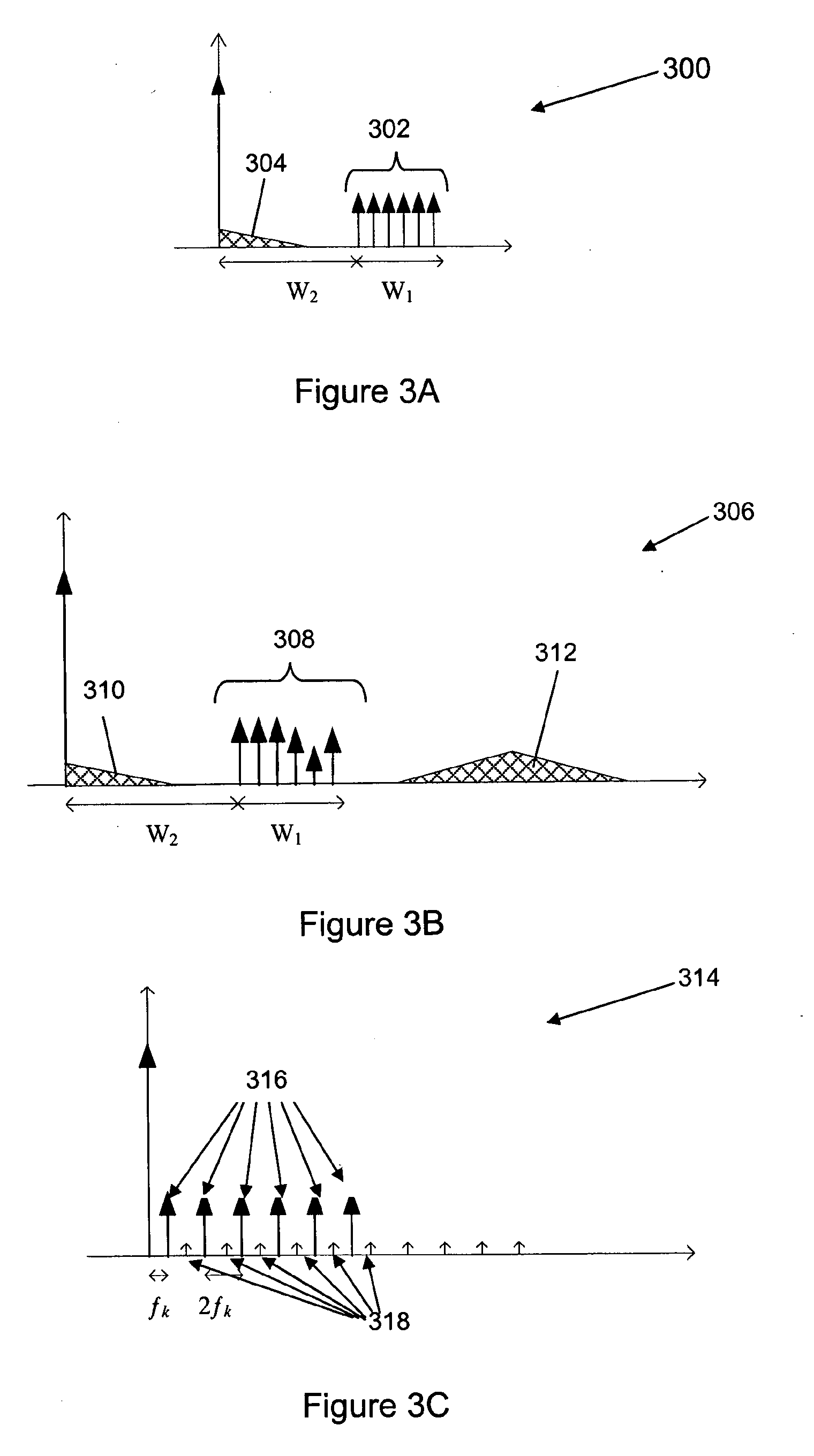[0018]However, it is a particular characteristic of IMDD optical transmission systems that no use is made of information contained in the phase of the transmitted
optical field, and indeed the optical phase information is substantially destroyed in the conventional direct detection process. This is unfortunate, because there are significant
optical processes leading to signal degradation, such as dispersion and certain nonlinear processes, which manifest themselves in frequency- and / or power-dependent changes in optical phase, and which can therefore be eliminated, or at least mitigated, by making suitable compensating adjustments to the transmitted and / or received optical phase. Such compensation may be performed in the electrical domain, substantially simplifying and / or improving the flexibility of optical transmission systems, only if the optical phase information remains available following optical-to-electrical conversion in the
receiver. It is generally believed that optical phase information can only be preserved into the electrical domain via the use of methods which increase the complexity and cost, and / or reduce the flexibility, of the
system, such as coherent optical detection.
[0020]The present invention, in at least preferred embodiments, therefore provides a number of improvements over the prior art. Firstly,
predistortion is applied which accounts for the nonlinear relationship between electrical signal amplitude and corresponding output
optical field amplitude, rather than output
optical power. Secondly, the information-bearing electrical signal that is originally created, prior to
predistortion and optical transmission, is composed so as to ensure that difference frequency components of the signal, which will be generated inherently by the square law nature of an optical direct
detector, do not interfere with the information-bearing spectral components of the signal. Together, the
predistortion and signal composition of the present invention enable the
recovery of the transmitted electrical signal at the receiving end in such a manner that distortions resulting from the nonlinear nature of the
transmitter and receiver may be substantially eliminated. Furthermore, by transmitting an optical carrier component along with the information-bearing optical signal, a direct detection receiver will recover the original transmitted signal spectral components within their original corresponding spectral bandwidth. The need for coherent detection, or other more complex and costly, or less flexible, detection schemes is avoided.
[0023]In a particularly preferred embodiment, the information-bearing electrical signal is composed using
orthogonal frequency division multiplexing (OFDM) techniques. The application of OFDM techniques in optical transmission systems has previously been disclosed in international
patent application no. PCT / AU2006 / 001282, and international
patent application no. PCT / AU2006 / 001511, both of which are incorporated herein in their entirety by reference. The use of OFDM methods provides a number of additional advantages in the context of the present invention. For example, OFDM enables a
very high level of control over the
frequency spectrum of the composed signal, which effectively consists of a large number of orthogonal frequency subcarriers, each of which is determined by a corresponding input to a frequency /
time transformation, typically implemented as a an inverse fast Fourier
transformer (IFFT). Composing a signal having a
frequency spectrum with the specified properties is therefore both simple and computationally efficient. Furthermore, as disclosed particularly in the two abovementioned international patent applications,
frequency domain equalisation techniques may be applied in combination with OFDM methods to compensate for the effects of
linear dispersion, and chromatic dispersion in particular.
[0030]As a further example, optical transmitters employing interference type modulators are now common, and such modulators operate by applying a
phase modulation to an optical carrier wave propagating in at least one path of an interferometric structure. A particularly preferred interferometric structure in integrated optical devices, such as planar
waveguide modulators, is a Mach-Zehnder structure. Interference type modulators may provide a
single electrode, to which a single electrical driving signal is applied, or may provide dual electrodes, or higher numbers of electrodes, allowing for varying degrees of control over the properties of the output optical signal. An in-phase / quadrature (IQ)
optical modulator is a particularly useful example of an interference type modulator, which consists of a “nested” interferometric structure which enables independent modulation of in-phase and quadrature components of the optical field.
[0033]Other implementations of interference-type modulators are configurable to an operator-defined bias point. When such modulators are employed, it is particularly preferred that the bias be set at the transmission “null” point, ie the minimum
transmission point, corresponding with maximum destructive interference at the interferometer output. Advantageously, when operated around this point the optical output field exhibits both positive and negative amplitude excursions, enabling the phase or “sign” of the optical signal to be controlled. As described above, an appropriate inverse-sinusoidal predistortion characteristic may readily be determined. However, by biasing the modulator at the minimum
transmission point, the need to apply a non-
negative bias to the information-bearing signal may be avoided, taking
advantage of the fact that a unique one-to-one relationship between positive / negative signal amplitude, and corresponding positive / negative optical field amplitude, can now be achieved. This may potentially result in improved
optical power efficiency and
dynamic range. For example, by employing the full range of the modulator about the transmission null, improved signal-to-
noise ratio may be achieved, enabling
higher order modulation schemes to be employed (such as
QAM schemes having increased numbers of
constellation points) in composing the information-bearing signal. Alternatively, by biasing the modulator slightly away from the transmission null, the
transmitter may be configured to automatically include the required optical carrier component in the transmitted signal. Such biasing may be achieved either directly, for example by control of fixed
voltage offsets applied to modulator electrodes, or by applying a suitable bias or offset to the information-bearing signal, which may be incorporated into the predistortion characteristic.
 Login to View More
Login to View More  Login to View More
Login to View More 


